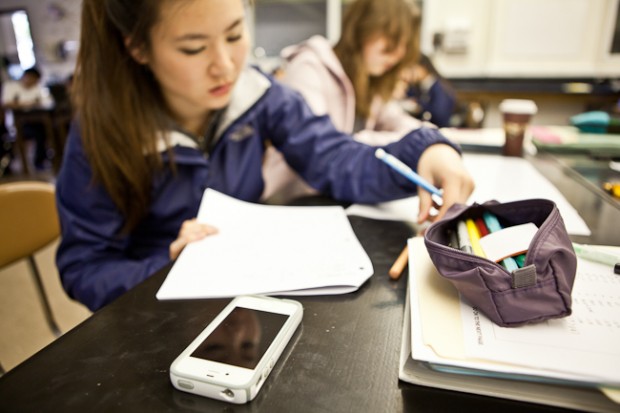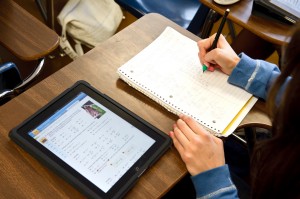
Erin Scott
As mobile learning programs become more ubiquitous, international attention is focusing on how different countries integrate mobile devices into formal schooling. Last month, United Nations Education, Scientific and Cultural Organization (UNESCO) released a comprehensive report called UNESCO Working Paper Series on Mobile Learning on the state of mobile learning around the world.
The report breaks down usage and policies in different areas, including North America, and part of the research focuses on "Essential Conditions for Mobile Learning." In this section of the report, researchers present five key conditions that must exist for a mobile learning initiative to succeed: visionary leadership and commitment, robust technology capacity, professional development, scalability, and policies that promote and support the initiative. Excerpted from the report:
1. VISIONARY LEADERSHIP AND COMMITMENT
Leadership and vision are central to the development of school reform efforts and mobile learning initiatives. Pioneering schools and districts with robust mobile learning programs often have strong, visionary leaders who promote and oversee the projects. While many national, state and provincial, and local policies have encouraged mobile learning, efforts to implement mobile learning programs are typically spearheaded by a school leader – often a principal, technology coordinator, district superintendent or university faculty member.
The project leader must cultivate a unified vision across the school or district, drawing in leaders from the curriculum and instruction, assessment, and technology departments. According to Lenny Schad, chief information officer for Katy Independent School District in Texas, it is critical that everyone involved in implementing the program has a clear understanding of the goals, intended outcomes, and expected benefits and risks. A mobile learning initiative should not be promoted as a technology initiative; rather, in order to win the broad support necessary for successful implementation, it should be positioned as an education initiative tied to clearly identifiable curricular goals. The education technology department must work closely with the curriculum and instruction department to ensure that their efforts and objectives are aligned. Part of the implementation must include adequate IT support, broadband access and teacher training.
2. ROBUST TECHNOLOGY CAPACITY
A successful mobile learning initiative requires a thorough analysis of the capacity of the existing technological infrastructure, with careful consideration and planning for the demands of the new program, including broadband access, hardware and software, and technical support. This analysis should include projections of demand and a review of recommendations for broadband requirements based on the number of users and bandwidth needs.
Ideally, wireless connectivity should be available throughout a school campus to maximize the potential of mobile learning. The increase in usage will require additional data storage, possibly off-site. Security and privacy must also be considered. Internet filters will need to comply with the district’s acceptable use policies as well as CIPA requirements in the United States. US institutions also must adhere to the Children’s Online Privacy Protection Act (COPPA), which regulates the online collection of personal data from children younger than 13 years of age.
3. PROFESSIONAL DEVELOPMENT
Many teachers will need training to successfully incorporate mobile learning into their pedagogical repertoire. Sharon Robinson, president and CEO of the American Association of Colleges for Teacher Education, said that most colleges and universities in the United States and Canada do not train teachers to integrate mobile learning into their instruction, and teachers have not typically had professional development opportunities specific to mobile learning.
First and foremost, teachers must have a basic understanding of the devices and their features. More importantly, though, they must learn how to use mobile technologies to change teaching and learning, so that they are doing more than just replacing print resources with digital versions. A common pitfall in incorporating new technology into education is over-reliance on the technology itself to produce results. [Mobile learning researchers] Marie Bjerede and Chris Dede, for instance, found that podcasting in and of itself had little effect on teaching and learning. When played in the classroom, podcasts are just high-tech versions of age-old instructional practices of "teaching by telling, learning by listening," previously accomplished with educational radio and portable tape recorders.
Researchers and education leaders say that improvements in student outcomes are more likely to occur if mobile learning initiatives lead to fundamental changes in instructional strategies. For example, in Saddleback Valley Unified School District in California, teachers participated in extensive professional development, including guidance on developing digital content and resources. Rather than trying to fit the new devices into the same instructional strategies, educators should be thinking critically about how they will deliver instruction differently using the opportunities afforded by mobile technologies. Professional development is key to helping teachers make the paradigm shift necessary to effectively integrate mobile devices into instruction.
Some educators stress the importance and potential of professional development that is available on demand and provides an individualized response to a teacher’s immediate needs. To fill gaps in professional development on mobile learning, some teachers have created or joined communities of practice or professional learning communities (PLCs). Teachers in PLCs meet regularly, either in person or online, to exchange ideas, share successes and discuss challenges they may be facing in the classroom. Within this collaborative structure, teachers can examine and improve their professional practice at a more flexible pace and with more opportunities for individualized support than is typically offered by traditional professional development programs.
4. SCALABILITY
Nearly every project leader of the mobile learning initiatives included in this review strongly encouraged a "start small, think big" mentality. Because mobile learning is still an emerging field, any new mobile learning program will likely encounter setbacks, and small-scale implementation can decrease risk and hasten recovery. For example, the pilot program at Canby School District in Oregon began with a few classrooms and then expanded on the basis of those experiences. Saddleback Valley Unified School District, Rockdale ISD and Katy ISD all built on the success of their pilot programs, often by increasing the number of students provided with mobile devices or adding a BYOT [bring your own technology] component in the upper grades.
Kyle Menchhofer, technology coordinator of St. Mary’s School in Ohio, said the school started its pilot program with five fifth-grade classrooms. In the second year, 29 teachers joined the project, with 630 mobile learning devices deployed in Grades 3 through 6. In the fourth year, because of the program’s great success, St. Mary’s implemented a BYOT pilot program in Grades 6 through 12. Although initial implementation might be small in scale, technology capacity should be addressed at the outset in preparation for large-scale implementation at a later date.
5. POLICIES THAT PROMOTE AND SUPPORT THE INITIATIVE
To support their mobile learning initiatives, many of the schools and districts surveyed for this paper eliminated policies that prohibited students from bringing mobile technologies to school and changed the wording in rules and guidance documents from "acceptable use" to "responsible use." The latter change reflects a shift in the institutional mindset: rather than simply policing mobile phone use, schools are moving toward making students responsible for their behavior with regard to mobile technology.
Successful implementation of a mobile learning initiative requires a thorough review of the school or district AUP to ensure that it reflects an updated philosophical perspective on the use of mobile devices on campus. The AUP should not be too restrictive with regard to the specific kinds of technology allowed, and the language should be more inclusive than exclusive. A number of organizations are working to help schools update their rules and policies to make room for flexible mobile learning programs and to better account for new and rapidly changing educational technologies. CoSN, with funding from a John D. and Catherine T. MacArthur Foundation grant, recently released a document that provides guidance to school leaders looking to revise AUPs.
Read UNESCO's report in full by downloading the PDF here.


